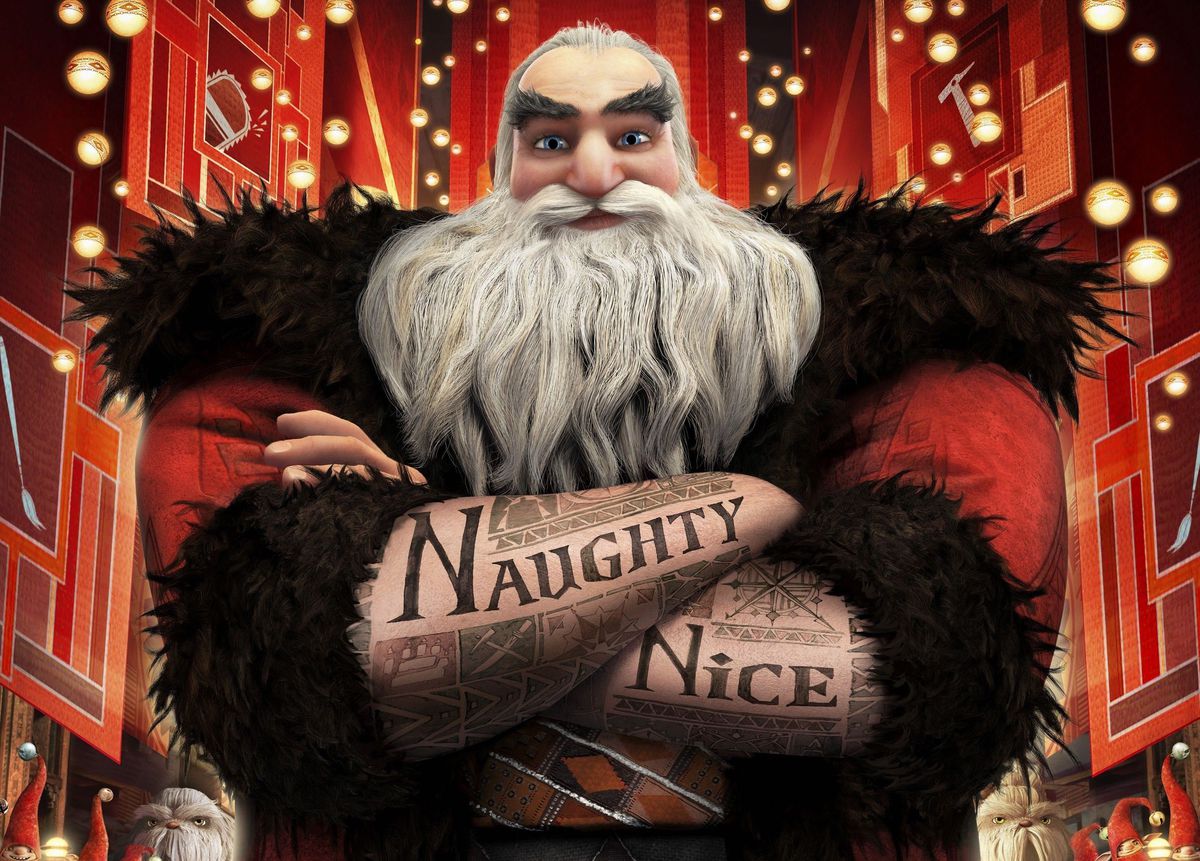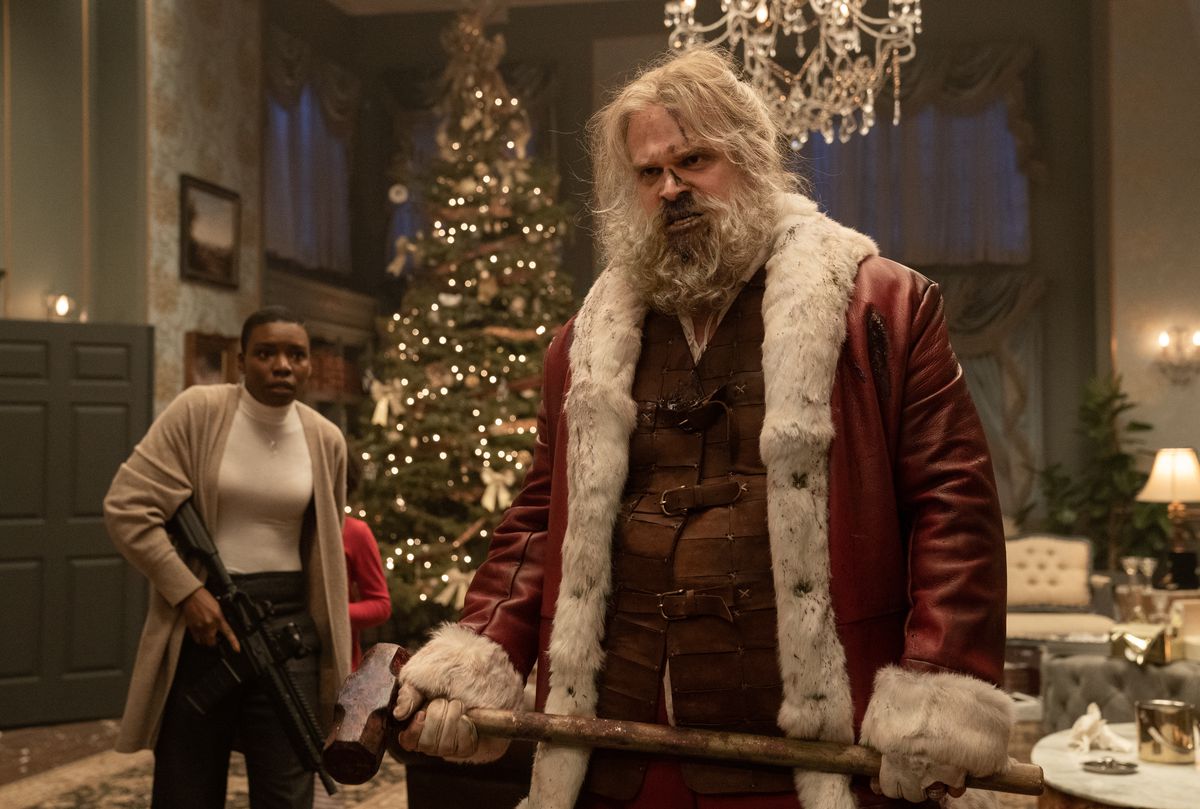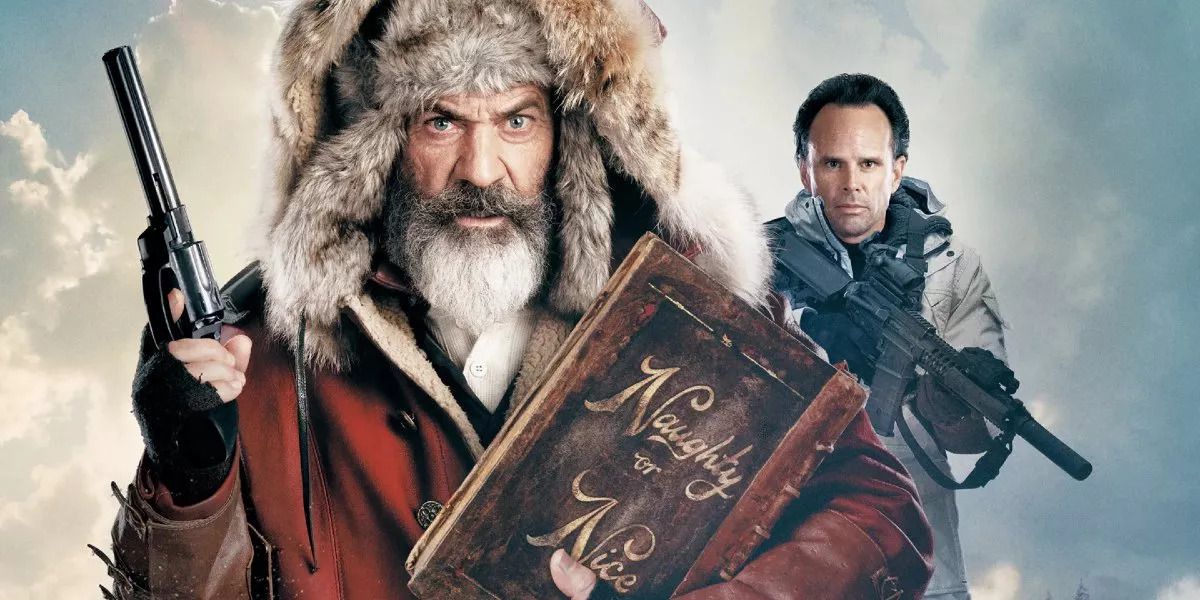It’s December 24th. The stockings are hung. The gifts are wrapped. The fireplace is crackling. You know the drill. You better watch out, you better not cry, you better not pout, I’m telling you why: If you do, Santa Claus will tear open a can of whoop-ass on you.
Old St. Nick wasn’t always the type who solves problems with his fists. Once upon a Christmas Eve, the jolly old elf pulled millions of B-and-Es in the U.S. to drop off presents and make folks happy. That was yesterday’s Nick. According to the movies, today’s Nick is a changed man, reimagined as either a superhero or a straight-up action hero. He’s gotten swole over the last 20 years, and he’s ready to rumble. But while his shape has changed, he represents the same qualities he always has. He’s just better prepared to fight for his values now, thanks in part to the ways America has recontextualized Christmas as a cultural battleground.
The idea that America was fomenting a war on Christmas came about in the early ’00s, when right-wing pundits warned the public about nefarious leftist schemes to secularize the holiday. To their credit, they were technically correct: Progressives had advocated for corporate and social adoption of “happy holidays” as a nondenominational season’s greeting, and pushed for communal celebration of culturally significant December holidays like Kwanzaa and Hanukkah. In progressive communities, menorah lightings conducted on town commons just 20 feet from a manger display didn’t strike a spiritual incongruity: They were welcomed.
Until conservative commentators like John Gibson and Bill O’Reilly declared that war was imminent, there wasn’t a war at all. They marshaled the media against neighborly accords between folks of diverse religious and ethnic backgrounds, and they’ve kept skirmishing against participatory secularism ever since. Pop culture eventually caught up on the fracas: Jon Stewart mocked pearl-clutching Christmas nonsense on The Daily Show; Funny or Die mashed up the trailers for Batman v Superman: Dawn of Justice and The Santa Clause; the YouTube sketch show wellRED Comedy used Ken Burns’ documentaries as a template for a chronicle of the history of the war on Christmas.

But while comics cracked jokes, Christmas’ most beloved symbolic figure went through a different transformation: Over the course of the last decade, Santa Claus slowly turned into a warrior. In 2012’s Rise of the Guardians, Santa is refashioned as Nicholas St. North, a strapping Russian charged with protecting children’s sense of wonder. In the 2018 and 2020 Christmas Chronicles movies, Santa is played with burly roguishness by Kurt Russell, a legend of Hollywood’s action-movie golden age, racing to prevent Christmas’ cancellation.
In 2020’s Fatman, Mel Gibson plays a version of Santa who works with the U.S. military, supplying them with parts for building high-tech fighter jets. And in Tommy Wirkola’s 2022 action-comedy Violent Night, Santa Claus (David Harbour) is a drunken curmudgeon living out a Die Hard scenario as he fights to save an exorbitantly wealthy family held hostage by a team of ruthless mercenaries.
These movies show a marked progression from whimsical children’s fantasy to R-rated hyperviolence. It took the movies almost 20 years to arrive at the logical conclusion of the manufactured Christmas culture war: an action film where old St. Nick launches a savage offensive to defend his holiday from bad guys who don’t believe in him.
Violent Night’s main villain, codenamed Scrooge (and played by John Leguizamo), is motivated both by abject loathing for Christmas, and by apparent moral disgust over how the rich become rich — and stay rich. Violent Night’s central family, the Lightstones, have a history of shady government dealings, including war profiteering. Scrooge excoriates Lightstone matriarch Gertrude (Beverly D’Angelo) in front of her daughter Alva (Edi Patterson), her son Jason (Alex Hassell), and their families about that history. Scrooge wants their money. The Lightstones stole it, he reasons, so stealing it from them is a victimless crime.

Violent Night’s ethical gymnastics are tangential to Santa’s existential gloom and crisis of faith. Early in the film, he complains that the modern world runs on greed. People think only about themselves and what they want. He’s less aggrieved that no one believes he’s real anymore, though he does have a slight chip on his shoulder about it. He’s more disgruntled over hastily scribbled, shallow wish lists.
“Video games, video games, video games,” reads one note left on a mantle for Santa to eyeball as he makes his annual trip around the globe. No wonder he takes his breaks pounding down pints at Bristol bars. Making kids’ dreams come true, as much as he can, is his mission. He couldn’t, for instance, make Trudy (Leah Brady), the youngest and most winsome Lightstone, fly — but he could give her a kite, several Christmases ago, that helped her touch the sky. Mindless commodification is anathema to that mission.
The reality is that Christmas has become a shopping holiday, but media versions of Santa have always resisted that message, going back to holiday TV specials like 1974’s The Year Without a Santa Claus. Even when there’s no Santa figure involved, Christmas specials have railed against the commercialization of the holiday, with 1965’s A Charlie Brown Christmas leading the charge.
The new interpretations of Santa just make that resistance more aggressive and physical. In Fatman, Chris Kringle shares misgivings similar to what Santa feels in Violent Night: He’s annoyed at the ways kids fetishize violence. He feels they’ve grown too callous. Given the rise of violent entertainment as diversion — Kringle particularly hates video games, much like Harbour’s Santa — it makes perfect sense that Uncle Sam makes Kringle an offer he genuinely can’t refuse. In Fatman, the U.S. government has subsidized Kringle’s gift-giving operation for decades. Refusing the military contract means losing those precious subsidies. Kringle complies. He has no choice.
As in Violent Night, Fatman’s Kringle works out his malaise by reluctantly fighting. When a spoiled rich kid finds a lump of coal in his stack of presents, he dispatches his personal hatchet man, Jonathan Miller (Walton Goggins), to bump Kringle off in retaliation. Jonathan bears a grudge against Christmas and Santa that dates back to his childhood, much like Scrooge in Violent Night. For both men, killing Santa would be cathartic.

The “war on Christmas” rabble-rousers should be tickled by Violent Night. As a villain, Scrooge is effectively an avatar for conservative panic over the left’s war on Christmas via secularization. The hero is Santa, the avatar of Christmas, who takes out the villain’s henchmen and massacres scores of anonymous cannon fodder while tossing out holiday one-liners: “Season’s beatings,” “Santa Claus is comin’ to town,” and admonishments of “That’s naughty!” barked at Scrooge’s sociopathic goons. Harbour’s Santa even weaponizes traditional holiday accouterments, like candy canes and tree decorations, as well as varied winter accessories, like ice skates and snowblowers. Tucker Carlson should be tittering in bloodthirsty glee.
Long before Wirkola and Fatman directors Eshom and Ian Nelms took their respective swings at Christmas genre films, though, pop culture repurposed Santa first as a Slavic swashbuckler in Peter Ramsey’s Rise of the Guardians, then as a grizzled cowboy rascal in The Christmas Chronicles. In the case of all three movies, entertainment is the main goal. Watching Ramsey treat Santa as part of a superhero ensemble, like a member of the Avengers or the League of Extraordinary Gentlemen, is a blast. And while the Christmas Chronicles movies don’t add up to much more than treacly sentimentalism, Russell’s magnetism and brawny charm make his Santa memorable.
Russell’s performance and Rise of the Guardians’ warm, noble take on Santa push back on the propaganda of the Christmas forever war: They’re broadly appealing films that reject the innate cynicism of the claim that Christmas is under attack because some people believe no one should feel barred from celebrating their own beliefs publicly in December. At a glance, Fatman and Violent Night in particular look like they’re affirming the war — they’re functionally low-key war movies that center on conflicts between Christmas-hating contract killers and Santa Claus. What could be a clearer allegory for “war on Christmas” than a small-scale literal war that takes place on Christmas?
For what it’s worth, neither Violent Night nor Fatman actually endorse the belief in the war on Christmas. They aren’t political, either, directly or indirectly. They’re simply a byproduct of that idea still echoing through American culture. They’re focused on the same arguments as Christmas movies dating back to 1946’s It’s a Wonderful Life: Greed and inhumanity have replaced compassion and charity, which should dominate the holiday season instead.
Still, Violent Night feels like a right-wing fantasy the way most action movies do — they’re fundamentally movies built around hawkish scenarios that can only be resolved with acts of pure violence. There’s nothing wrong with cheering for good guys mowing down bad guys, but it’s a contradictory approach to these movies’ nostalgic call for Christmas warmth, cheer, and goodwill toward humanity.
Violent Night, Fatman, Christmas Chronicles 1 and 2, and Rise of the Guardians all reinforce themes from Christmas classics about avarice as the holiday’s truest opposition. What’s different about these films is that they’ve been made in a world where people honestly seem to believe that traditional holiday values are battling against the spirit of inclusion and joyous community celebration, and that those values need to be defended with guns and sledgehammers.
Like so many other “dark Christmas” stories, from horror movies like Silent Night, Deadly Night to caustic comedies like Bad Santa, the action-Santa movies are playing around with familiar iconography, adding some grit and adult humor for the kinds of viewers who find traditional holiday treacle a little too sweet. But it feels dubious to see Santa defend vigilantism and slaughter in the same breath that he’s using to defend anti-commercialist messages and the wonder and magic of childhood. It’s worth being aware of the other, more troublesome messages these superhero Santas are defending at the same time.
- SEO Powered Content & PR Distribution. Get Amplified Today.
- Platoblockchain. Web3 Metaverse Intelligence. Knowledge Amplified. Access Here.
- Source: https://www.polygon.com/23495040/violent-night-fatman-superhero-action-santa



